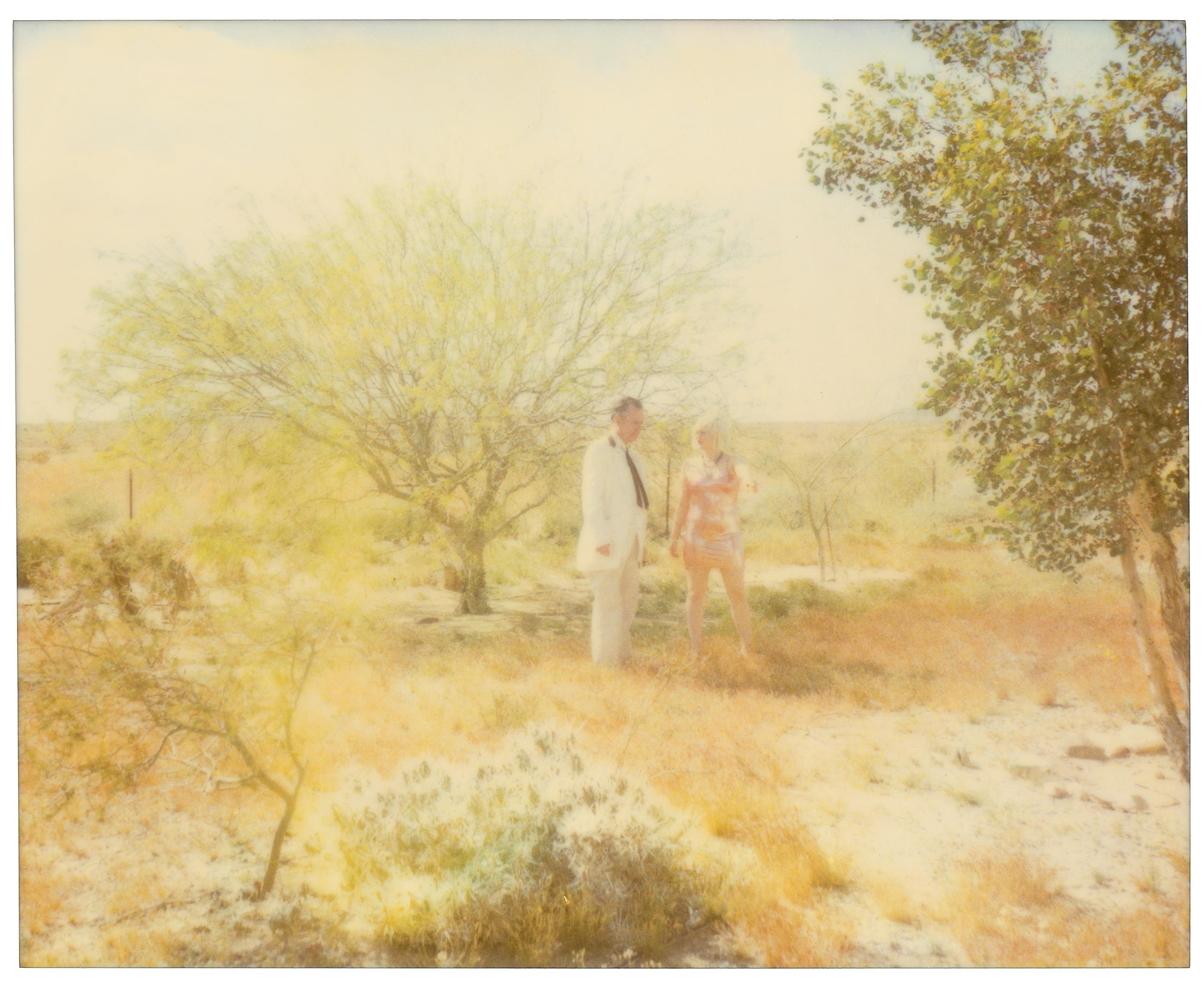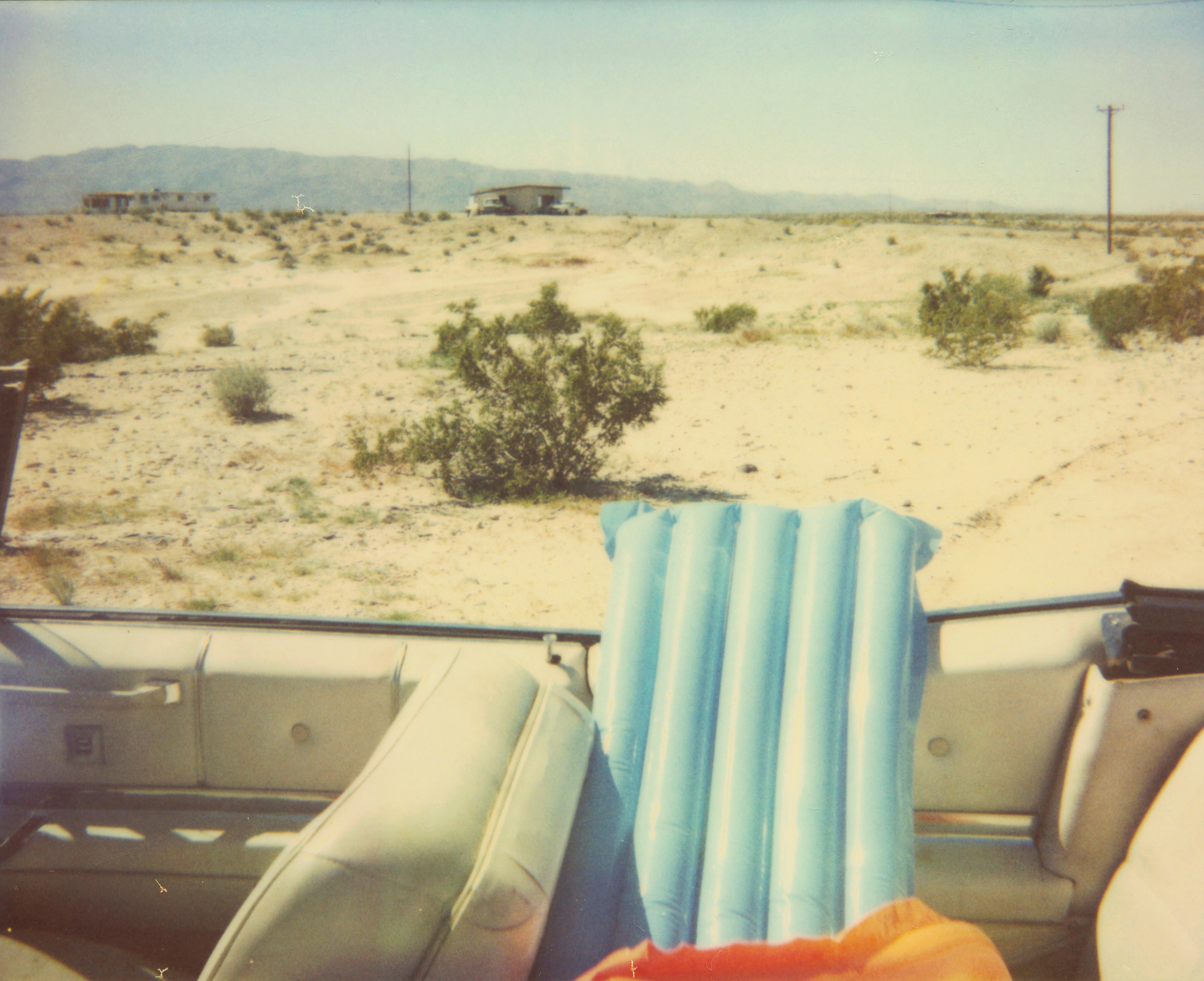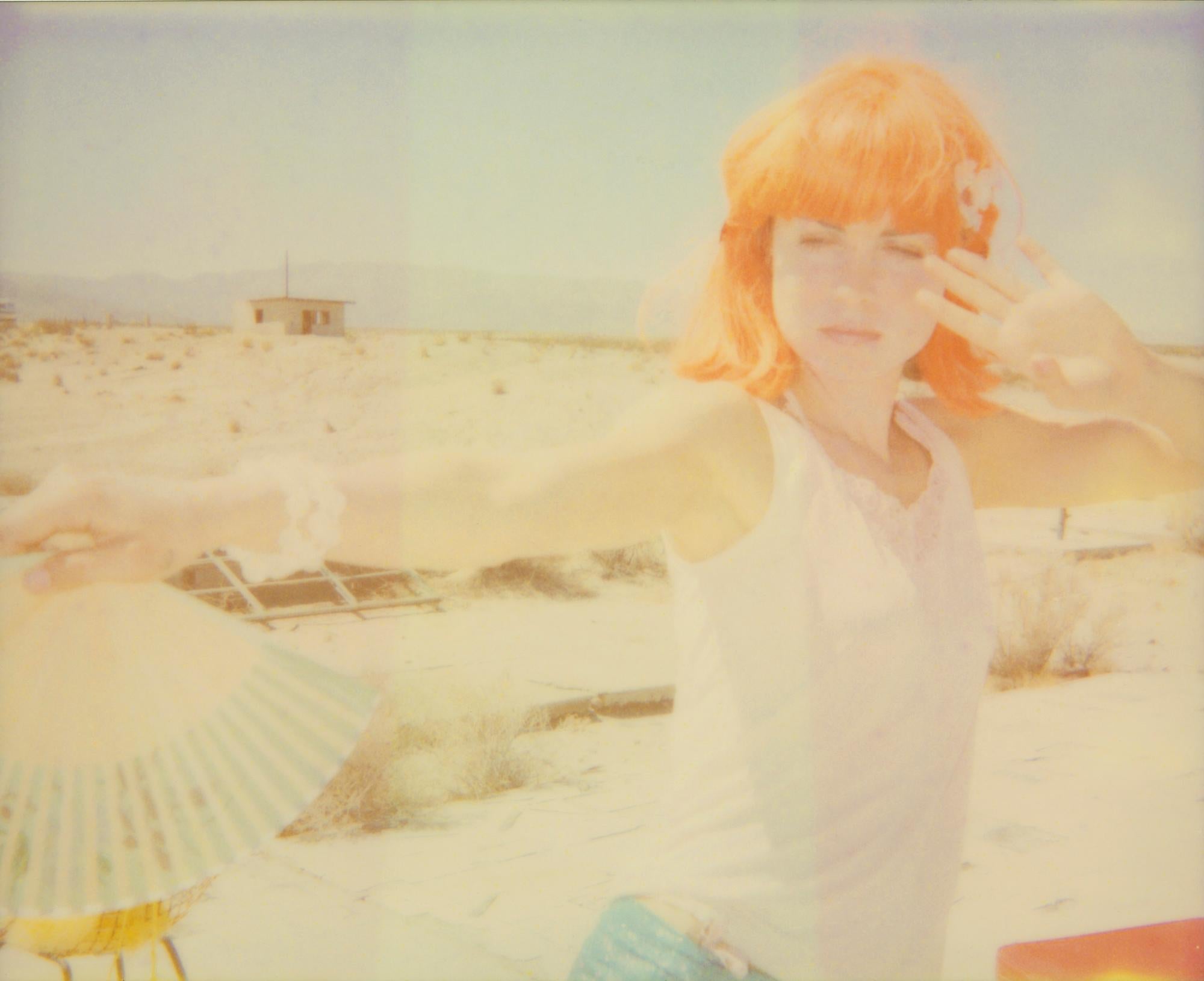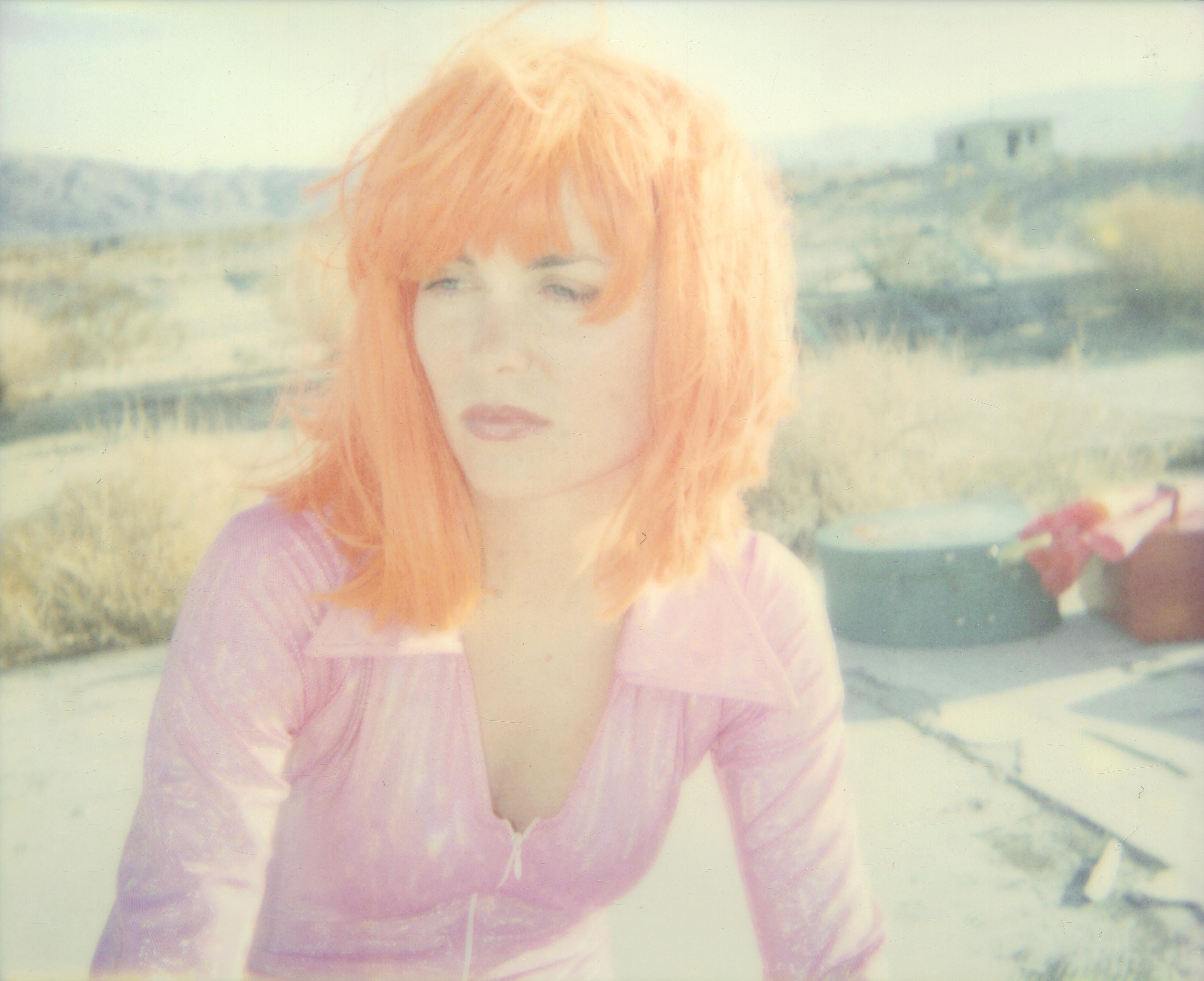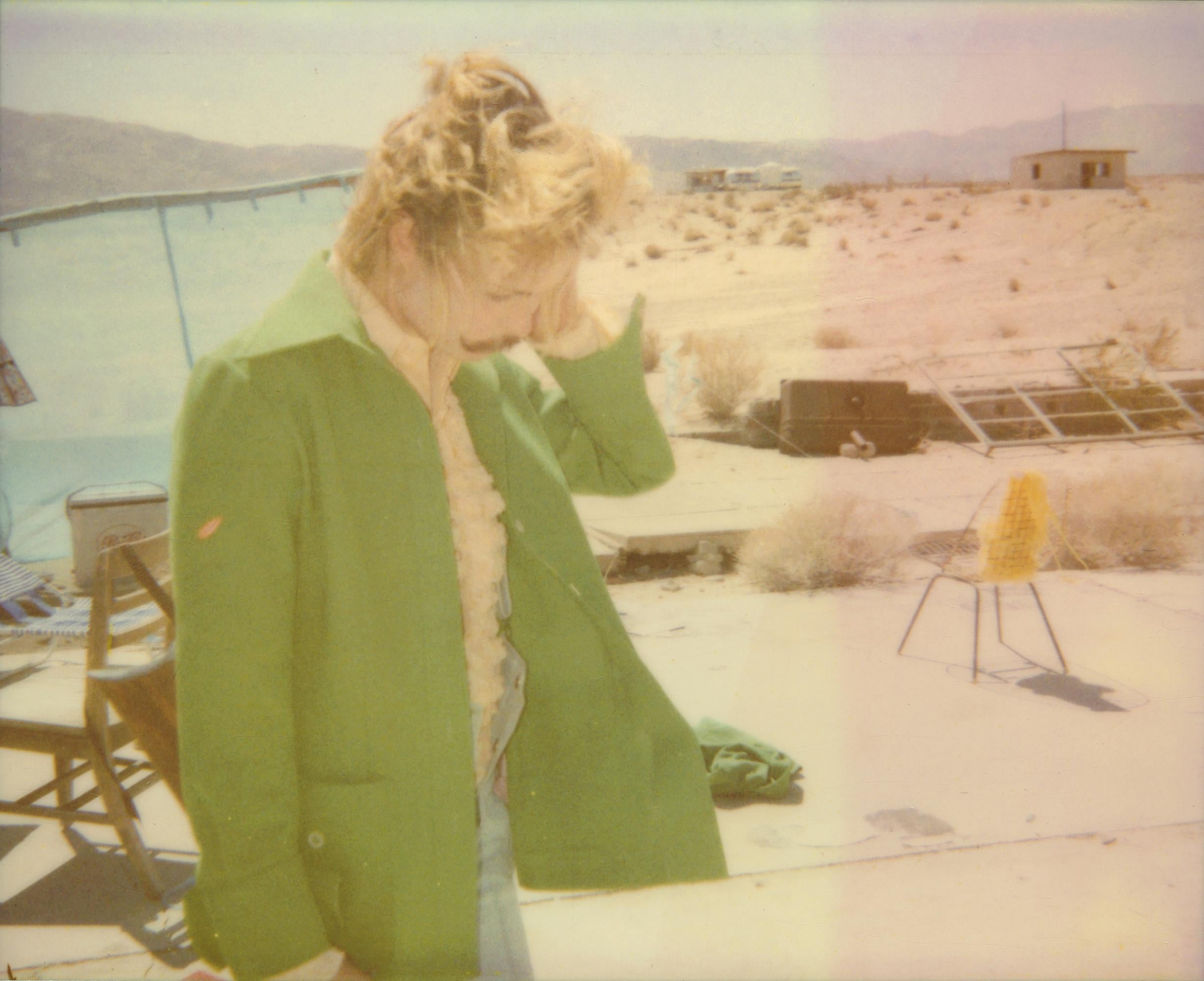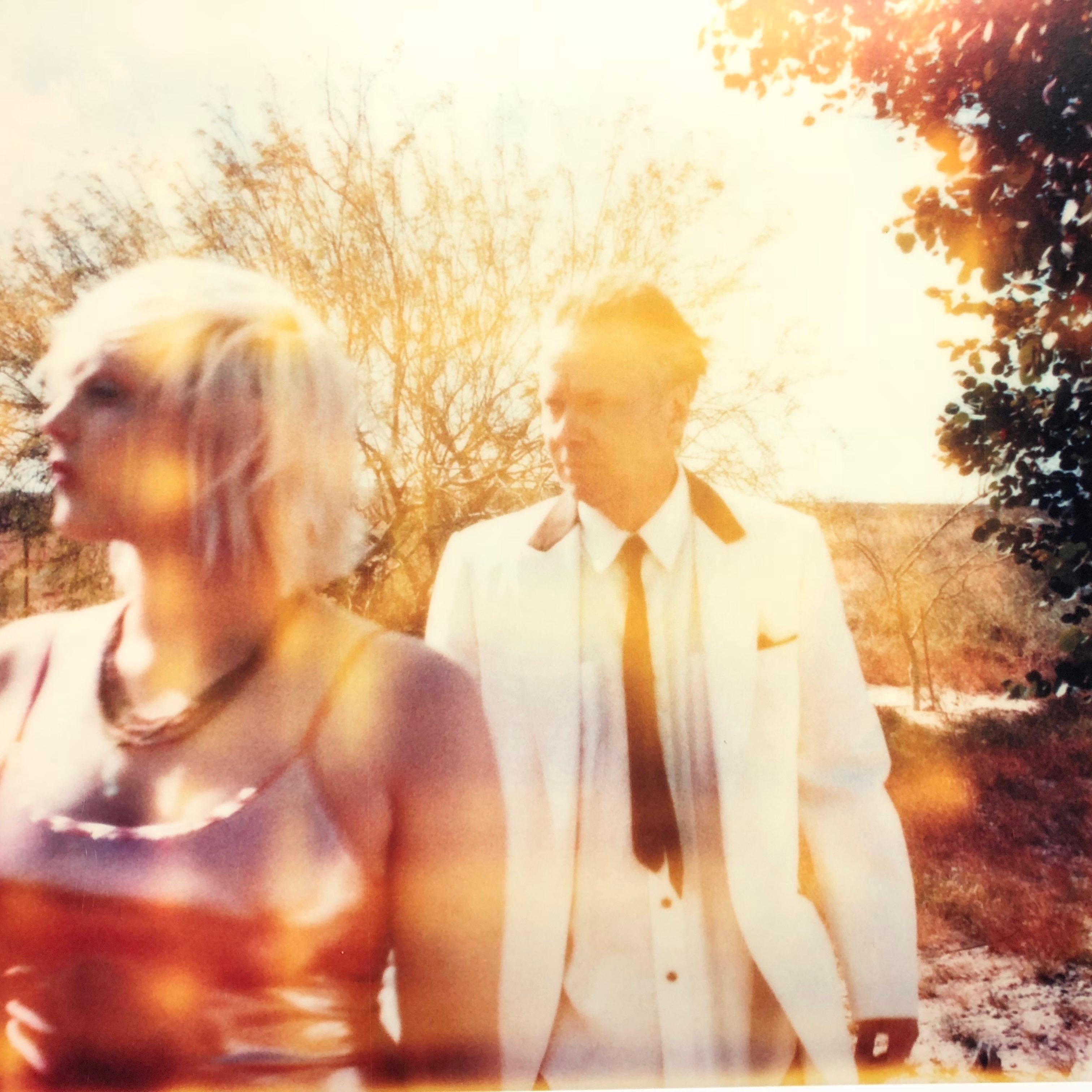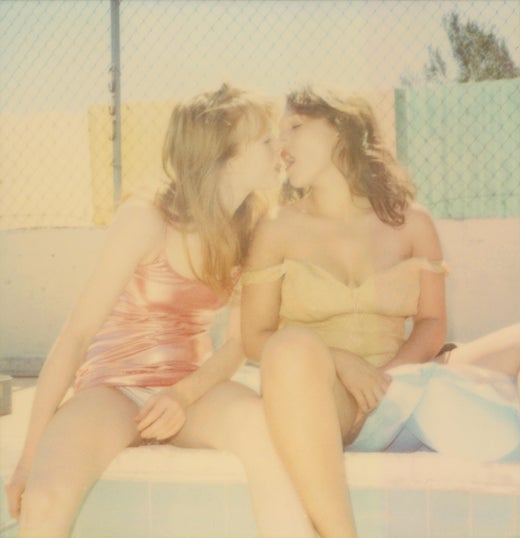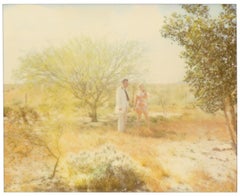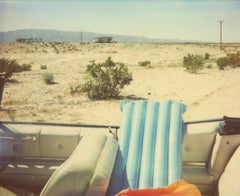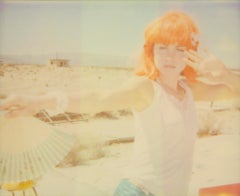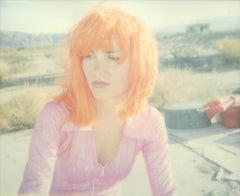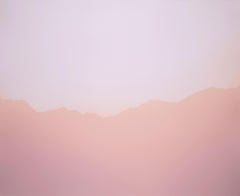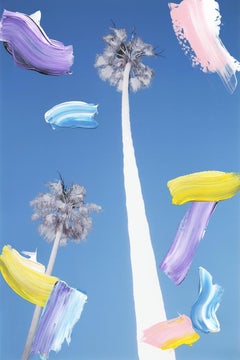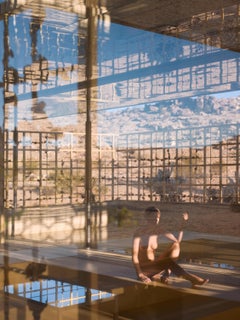Items Similar to Thursday II (Wonder Valley)
Want more images or videos?
Request additional images or videos from the seller
1 of 5
Stefanie SchneiderThursday II (Wonder Valley)2005
2005
$700
£534.35
€614.27
CA$985.03
A$1,095.39
CHF 575.32
MX$13,392.23
NOK 7,169.06
SEK 6,758.49
DKK 4,584.47
About the Item
Thursday I (Wonder Valley) - 2005
40x48cm,
Edition of 10.
Archival Print, based on the Polaroid.
Certificate and Signature label.
Artist Inventory #3646.
Not mounted.
published in Stranger than Paradise, Hatje Cantz, 2005 (monograph)
LIFE’S A DREAM
(The Personal World of Stefanie Schneider)
by Mark Gisbourne
Projection is a form of apparition that is characteristic of our human nature, for what we imagine almost invariably transcends the reality of what we live. And, an apparition, as the word suggests, is quite literally ‘an appearing’, for what we appear to imagine is largely shaped by the imagination of its appearance. If this sounds tautological then so be it. But the work of Stefanie Schneider is almost invariably about chance and apparition. And, it is through the means of photography, the most apparitional of image-based media, that her pictorial narratives or photo-novels are generated. Indeed, traditional photography (as distinct from new digital technology) is literally an ‘awaiting’ for an appearance to take place, in line with the imagined image as executed in the camera and later developed in the dark room. The fact that Schneider uses out-of-date Polaroid film stock to take her pictures only intensifies the sense of their apparitional contents when they are realised. The stability comes only at such time when the images are re-shot and developed in the studio, and thereby fixed or arrested temporarily in space and time.
The unpredictable and at times unstable film she adopts for her works also creates a sense of chance within the outcome that can be imagined or potentially envisaged by the artist Schneider. But this chance manifestation is a loosely controlled, or, better called existential sense of chance, which becomes pre-disposed by the immediate circumstances of her life and the project she is undertaking at the time. Hence the choices she makes are largely open-ended choices, driven by a personal nature and disposition allowing for a second appearing of things whose eventual outcome remains undefined. And, it is the alliance of the chance-directed material apparition of Polaroid film, in turn explicitly allied to the experiences of her personal life circumstances, that provokes the potential to create Stefanie Schneider’s open-ended narratives. Therefore they are stories based on a degenerate set of conditions that are both material and human, with an inherent pessimism and a feeling for the sense of sublime ridicule being seemingly exposed. This in turn echoes and doubles the meaning of the verb ‘to expose’. To expose being embedded in the technical photographic process, just as much as it is in the narrative contents of Schneider’s photo-novel exposés. The former being the unstable point of departure, and the latter being the uncertain ends or meanings that are generated through the photographs doubled exposure.
The large number of speculative theories of apparition, literally read as that which appears, and/or creative visions in filmmaking and photography are self-evident, and need not detain us here. But from the earliest inception of photography artists have been concerned with manipulated and/or chance effects, be they directed towards deceiving the viewer, or the alchemical investigations pursued by someone like Sigmar Polke. None of these are the real concern of the artist-photographer Stefanie Schneider, however, but rather she is more interested with what the chance-directed appearances in her photographs portend. For Schneider’s works are concerned with the opaque and porous contents of human relations and events, the material means are largely the mechanism to achieving and exposing the ‘ridiculous sublime’ that has come increasingly to dominate the contemporary affect(s) of our world. The uncertain conditions of today’s struggles as people attempt to relate to each other - and to themselves - are made manifest throughout her work. And, that she does this against the backdrop of the so-called ‘American Dream’, of a purportedly advanced culture that is Modern America, makes them all the more incisive and critical as acts of photographic exposure.
From her earliest works of the late nineties one might be inclined to see her photographs as if they were a concerted attempt at an investigative or analytic serialisation, or, better still, a psychoanalytic dissection of the different and particular genres of American subculture. But this is to miss the point for the series though they have dates and subsequent publications remain in a certain sense unfinished. Schneider’s work has little or nothing to do with reportage as such, but with recording human culture in a state of fragmentation and slippage. And, if a photographer like Diane Arbus dealt specifically with the anomalous and peculiar that made up American suburban life, the work of Schneider touches upon the alienation of the commonplace. That is to say how the banal stereotypes of Western Americana have been emptied out, and claims as to any inherent meaning they formerly possessed has become strangely displaced. Her photographs constantly fathom the familiar, often closely connected to traditional American film genre, and make it completely unfamiliar. Of course Freud would have called this simply the unheimlich or uncanny. But here again Schneider almost never plays the role of the psychologist, or, for that matter, seeks to impart any specific meanings to the photographic contents of her images. The works possess an edited behavioural narrative (she has made choices), but there is never a sense of there being a clearly defined story. Indeed, the uncertainty of my reading here presented, acts as a caveat to the very condition that Schneider’s photographs provoke.
Invariably the settings of her pictorial narratives are the South West of the United States, most often the desert and its periphery in Southern California. The desert is a not easily identifiable space, with the suburban boundaries where habitation meets the desert even more so. There are certain sub-themes common to Schneider’s work, not least that of journeying, on the road, a feeling of wandering and itinerancy, or simply aimlessness. Alongside this subsidiary structural characters continually appear, the gas station, the automobile, the motel, the highway, the revolver, logos and signage, the wasteland, the isolated train track and the trailer. If these form a loosely defined structure into which human characters and events are cast, then Schneider always remains the fulcrum and mechanism of their exposure. Sometimes using actresses, friends, her sister, colleagues or lovers, Schneider stands by to watch the chance events as they unfold. And, this is even the case when she is a participant in front of camera of her photo-novels. It is the ability to wait and throw things open to chance and to unpredictable circumstances, that marks the development of her work over the last eight years. It is the means by which random occurrences take on such a telling sense of pregnancy in her work.
However, in terms of analogy the closest proximity to Schneider’s photographic work is that of film. For many of her titles derive directly from film, in photographic series like OK Corral (1999), Vegas (1999), Westworld (1999), Memorial Day (2001), Primary Colours (2001), Suburbia (2004), The Last Picture Show (2005), and in other examples. Her works also include particular images that are titled Zabriskie Point, a photograph of her sister in an orange wig. Indeed the tentative title for the present publication Stranger Than Paradise is taken from Jim Jarmusch’s film of the same title in 1984. Yet it would be dangerous to take this comparison too far, since her series 29 Palms (1999) presages the later title of a film that appeared only in 2002. What I am trying to say here is that film forms the nexus of American culture, and it is not so much that Schneider’s photographs make specific references to these films (though in some instances they do), but that in referencing them she accesses the same American culture that is being emptied out and scrutinised by her photo-novels. In short her pictorial narratives might be said to strip films of the stereotypical Hollywood tropes that many of them possess. Indeed, the films that have most inspired her are those that similarly deconstruct the same sentimental and increasingly tawdry ‘American Dream’ peddled by Hollywood. These include films like David Lynch’s Blue Velvet (1986), Wild at Heart (1990) The Lost Highway (1997), John Dahl’s The Last Seduction (1994) or films like Ridley Scott’s Thelma and Louise with all its girl-power Bonny and Clyde-type clichés. But they serve no more than as a backdrop, a type of generic tableau from which Schneider might take human and abstracted elements, for as commercial films they are not the product of mere chance and random occurrence.
Notwithstanding this observation, it is also clear that the gender deconstructions that the characters in these films so often portray, namely the active role of women possessed of a free and autonomous sexuality (even victim turned vamp), frequently find resonances within the behavioural events taking place in Schneider’s photographs and DVD sequences; the same sense of sexual autonomy that Stefanie Schneider possesses and is personally committed to.
I
- Creator:Stefanie Schneider (1968, German)
- Creation Year:2005
- Dimensions:Height: 15.75 in (40 cm)Width: 18.9 in (48 cm)Depth: 0.04 in (1 mm)
- Medium:
- Movement & Style:
- Period:
- Framing:Framing Options Available
- Condition:
- Gallery Location:Morongo Valley, CA
- Reference Number:1stDibs: LU652314204942
Stefanie Schneider
Stefanie Schneider received her MFA in Communication Design at the Folkwang Schule Essen, Germany. Her work has been shown at the Museum for Photography, Braunschweig, Museum für Kommunikation, Berlin, the Institut für Neue Medien, Frankfurt, the Nassauischer Kunstverein, Wiesbaden, Kunstverein Bielefeld, Museum für Moderne Kunst Passau, Les Rencontres d'Arles, Foto -Triennale Esslingen., Bombay Beach Biennale 2018, 2019.
About the Seller
4.9
Platinum Seller
Premium sellers with a 4.7+ rating and 24-hour response times
Established in 1996
1stDibs seller since 2017
1,037 sales on 1stDibs
Typical response time: 2 hours
- ShippingRetrieving quote...Shipping from: Morongo Valley, CA
- Return Policy
Authenticity Guarantee
In the unlikely event there’s an issue with an item’s authenticity, contact us within 1 year for a full refund. DetailsMoney-Back Guarantee
If your item is not as described, is damaged in transit, or does not arrive, contact us within 7 days for a full refund. Details24-Hour Cancellation
You have a 24-hour grace period in which to reconsider your purchase, with no questions asked.Vetted Professional Sellers
Our world-class sellers must adhere to strict standards for service and quality, maintaining the integrity of our listings.Price-Match Guarantee
If you find that a seller listed the same item for a lower price elsewhere, we’ll match it.Trusted Global Delivery
Our best-in-class carrier network provides specialized shipping options worldwide, including custom delivery.More From This Seller
View AllThursday I (Wonder Valley)
By Stefanie Schneider
Located in Morongo Valley, CA
Thursday I (Wonder Valley) - 2005
20x24cm,
Edition of 10,
archival Print, based on a Polaroid.
Certificate and Signature label.
Artist Inventory #3640.
Not mounted.
published ...
Category
2010s Contemporary Color Photography
Materials
Archival Paper, Photographic Paper, C Print, Color, Polaroid
Wonder Valley (Till Death...) - including the book 'A Half Forgotten Dream'
By Stefanie Schneider
Located in Morongo Valley, CA
Wonder Valley (Till Death Do Us Part) - 2005
Including Stefanie Schneider's new monograph "A Half Forgotten Dream" signed. 192 pages, hardcover, published by Snap Collective, 2024. ...
Category
Early 2000s Contemporary Color Photography
Materials
Archival Paper, Photographic Paper, C Print, Color, Polaroid
Untitled - Stage of Consciousness - last edition
By Stefanie Schneider
Located in Morongo Valley, CA
'Untitled' (Stage of Consciousness), 2007, 20x24cm,
sold out Edition of 5, Artist Proof 1/2,
digital C-Print, based on a Polaroid, Certificate and Signature label, artist Inventory ...
Category
Early 2000s Contemporary Color Photography
Materials
Archival Paper, Photographic Paper, C Print, Color, Polaroid
Untitled - Stage of Consciousness (29 Palms, CA) - analog, mounted
By Stefanie Schneider
Located in Morongo Valley, CA
Untitled - Stage of Consciousness (29 Palms, CA) - 2007
75x93cm,
Edition 5/5
analog C-Print, hand-printed by the artist on Fuji Crystal Archive Paper, based on the Polaroid,
Arti...
Category
Early 2000s Contemporary Color Photography
Materials
Archival Paper, Photographic Paper, C Print, Color, Polaroid
$3,150 Sale Price
30% Off
Because I Am (29 Palms, CA) - including the book 'A Half Forgotten Dream'
By Stefanie Schneider
Located in Morongo Valley, CA
Because I Am (Stage of Consciousness) - 2008
including Stefanie Schneider's new monograph "A Half Forgotten Dream" signed. 196 pages, hardcover, published by Snap Collective, 2024. ...
Category
Early 2000s Contemporary Color Photography
Materials
Archival Paper, Photographic Paper, C Print, Color, Polaroid
Wonder Valley (29 Palms, CA)
By Stefanie Schneider
Located in Morongo Valley, CA
Wonder Valley (29 Palms, CA) - 2006
20x20cm,
Edition of 5 plus 2 Artist Proofs.
Archival C-Print, based on the Polaroid.
Certificate and Signature Label.
Artist inventory Number ...
Category
Early 2000s Contemporary Figurative Photography
Materials
Archival Paper, Photographic Paper, C Print, Color, Polaroid
You May Also Like
Untitled #46
By Vanessa Marsh
Located in Sante Fe, NM
Vanessa Marsh is an American artist living and working in California. Her series The Sun Beneath the Sky reflects upon the nature of light, atmosphere, geology and time. Layers of pa...
Category
2010s Contemporary Landscape Photography
Materials
Photogram
Untitled #35
By Vanessa Marsh
Located in Sante Fe, NM
Vanessa Marsh is an American artist living and working in California. Her series The Sun Beneath the Sky reflects upon the nature of light, atmosphere, geology and time. Layers of pa...
Category
2010s Contemporary Landscape Photography
Materials
Photogram
LA 2015
By Madeleine Gross
Located in New York, NY
ABOUT THIS ARTIST: Madeleine Gross is a Toronto-based artist who customizes her photographs with paint in a way designed to abstract landscapes but wit...
Category
2010s Color Photography
Materials
Photographic Paper
She Disappeared into Complete Silence (AD7258) - abstract figurative photograph
By Mona Kuhn
Located in San Francisco, CA
In the series 'She Disappeared into Complete Silence' (2014) Mona Kuhn takes a new direction into abstraction.
She turns to a highly austere and restrained reductionist geometry and distilled formal purity, connecting the interior to the exterior, the visible to the hidden. These reflections cause one to linger, as they merge to create a dynamic equilibrium of tension, spaces and rythms.
Mona Kuhn (AD7258) (She Disappeared into Complete Silence)
30" x 40" / 76cm x 102cm
edition of 8 + 2AP
45" x 60" / 114cm x 152cm
edition of 8 + 2AP
limited edition photograph printed under artist supervision + accompanied by signed artist certificate:
artist signature labels are 8x10 in size
signed, editioned, dated and titled by the artist, and stamped for authenticity
label is placed centered on verso of the mounted print
__________________
About the artist
Acclaimed for her contemporary depictions, Kuhn is considered a leading artist in the world of figurative discourse. Throughout a career spanning more than twenty years, the underlying theme of her work is her reflection on humanity’s longing for spiritual connection and solidarity. As she solidified her photographic style, Kuhn created a notable approach to the nude by developing friendships with her subjects, and employing a range of playful visual strategies that use natural light and minimalist settings to evoke a sublime sense of comfort between the human figure and its environment. Her work is natural, restful, and a reinterpretation of the nude in the canon of contemporary art.
For the past two decades, the Los-Angeles based artist's works have been shown steadily, revealing an astonishing consistency in technique, of subject and of purpose. In 2001, Kuhn’s photographs were first seen by an influential audience during the exhibition at Charles Cowles Gallery in Chelsea, New York. Kuhn’s distinct aesthetic has propelled her as one of the most collectible contemporary art photographers—her work is in private and public collections worldwide and she is represented by galleries across the United States, Europe and Asia.
Kuhn was born in São Paulo, Brazil, in 1969, of German descent. In 1989, Kuhn moved to the US and earned her BA from The Ohio State University, before furthering her studies at the San Francisco Art Institute. She is currently an independent scholar at The Getty Research Institute in Los Angeles. Occasionally, Mona teaches at UCLA and the Art Center College of Design in Pasadena.
Mona Kuhn’s first monograph, Photographs, was debuted by Steidl in 2004; followed by Evidence (2007), Native (2010), Bordeaux Series (2011), Private (2014), and She Disappeared into Complete Silence (2018/19). In addition, Kuhn's monograph titled Bushes and Succulents has been published by Stanley/Barker Editions, with a debut at Jeu de Paume in Paris, in 2019. A stunning career retrospective of Mona Kuhn's works has been published by Thames & Hudson, Spring 2021. Kuhn's forthcoming publication Kings Road, will be published and released by Steid this Fall 2021.
Mona Kuhn’s work is in private and public collections worldwide, including The J. Paul Getty Museum, Los Angeles County Museum of Art, The Hammer Museum, Perez Art Museum Miami, Museum of Fine Arts, Houston, and the Kiyosato Museum in Japan. Kuhn's work has been exhibited at The Louvre Museum and Le Bal in Paris; The Whitechapel Gallery and Royal Academy of Arts in London; Musée de l’Elysée in Switzerland; Leopold Museum in Vienna Austria, The Polygon Gallery in Vancouver Canada, Taipei Fine Arts Museum in Taiwan and Australian Centre for Photography. Mona Kuhn lives and works in Los Angeles.
__________________
Solo Exhibitions
2021
Mona Kuhn: Selected Works, Galerie XII, Paris
Mona Kuhn: Works, Edwynn Houk Gallery, New York
Mona Kuhn: Works, Flowers Gallery, London
Mona Kuhn: Works, Galerie XII, Los Angeles + Paris + Shanghai
Mona Kuhn: 835 Kings Road, Art, Design and Architecture Museum, Santa Barbara
2020
Still Light, Jardin du Bra'haus, Montée du Château, Clervaux, Luxembourg
Mona Kuhn: Early Depictions, Flowers Gallery, London
Mona Kuhn: Intimate, UP Gallery, Taipei, Taiwan
2019
Bushes and Succulents, Euqinom Gallery, San Francisco
Mona Kuhn: She Disappeared, Jackson Fine Art...
Category
21st Century and Contemporary Contemporary Color Photography
Materials
Photographic Film, Photographic Paper, Silver Gelatin
Untitled (Nr. 4564) Figurative Photography 44" x 36" in Ed of 12 by Rowan Daly
By Rowan Daly
Located in Culver City, CA
Untitled (Nr. 4564) Figurative Photography 44" x 36" in Ed of 12 by Rowan Daly
Unframed - ships rolled in a tube
Ben Cope + Rowan Daly Off the Grid
Off the Grid is the culminati...
Category
21st Century and Contemporary Contemporary Landscape Prints
Materials
Archival Pigment
Sister
By Sarah Elise Abramson
Located in Santa Monica, CA
Photography, edition 2/20.
Category
2010s Contemporary Nude Photography
Materials
Color
$576 Sale Price
20% Off
